
Seattle Seahawks
USIFNO | 2013-08-04 18:50
| Seattle Seahawks | |||
| Current season | |||
|
Established 1975 Play in CenturyLink Field Seattle, Washington Headquartered in the Virginia Mason Athletic Center Renton, Washington |
|||
|
|||
| League/conference affiliations | |||
|
National Football League (1976–present) National Football Conference (1976) NFC West (1976) American Football Conference (1977–2001) AFC West (1977–2001) National Football Conference (2002–present) NFC West (2002–present) |
|||
| Current uniform | |||
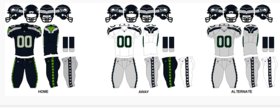 |
|||
| Team colors |
College Navy, Action Green, Wolf Grey, White [1] |
||
| Mascot | Blitz, and Taima the Hawk (since 2007) | ||
| Personnel | |||
| Owner(s) | Paul Allen | ||
| Chairman | Paul Allen | ||
| CEO | Peter McLoughlin | ||
| General manager | John Schneider | ||
| Head coach | Pete Carroll | ||
| Team history | |||
| Seattle Seahawks (1976–present) | |||
| Championships | |||
| League championships (0) | |||
|
Conference championships (1) NFC: 2005 |
|||
|
Division championships (7) AFC West: 1988, 1999 NFC West: 2004, 2005, 2006, 2007, 2010 |
|||
| Playoff appearances (12) | |||
| NFL: 1983, 1984, 1987, 1988, 1999, 2003, 2004, 2005, 2006, 2007, 2010, 2012 | |||
| Home fields | |||
|
The Kingdome (1976–1999), Played first half of the 1994 season at Husky Stadium Husky Stadium (First half of the 1994 season due to repairs at The Kingdome; 2000–2001) CenturyLink Field (2002–present) a.k.a. Seahawks Stadium (2002–2003) a.k.a. Qwest Field (2004–2010) |
|||
The Seattle Seahawks are an American Football team in the National Football League based in Seattle, Washington. They are currently members of the Western Division of the National Football Conference (NFC), and joined the NFL in 1976 as an expansion team along with the Tampa Bay Buccaneers. The Seahawks have had some notable stars on the team, such as Steve Largent, Jim Zorn, Dave Krieg, Kenny Easley, Curt Warner, Joe Nash, Brian Blades, Cortez Kennedy, Joey Galloway, Warren Moon, Walter Jones, Shaun Alexander, Matt Hasselbeck, Russell Wilson and Marshawn Lynch. Two of them have inducted into the Pro Football Hall of Fame and some have been inducted into the Seahawks Ring of Honor. Seattle is the only team to have played in the AFC (American Football Conference) and NFC Championship Games, winning the latter. The Seahawks have won seven division titles, the first two from 1988 and 1999 coming from the AFC West, and their only Super Bowlappearance was in 2006 for Super Bowl XL.
Franchise history
For more details on this topic, see History of the Seattle Seahawks.
On June 15, 1972, Seattle Professional Football Inc., a group of Seattle business and community leaders, announced its intention to acquire an NFL franchise for the city of Seattle, WA.[2] Around two years later on June 4, 1974, the NFL gave the city an expansion franchise. On December 5, 1974, NFL Commissioner Pete Rozelle announced the official signing of the franchise agreement byLloyd W. Nordstrom, representing the Nordstrom family as majority partners for the consortium. Nordstrom died of a heart attack before the Seahawks played their first game.[3]
On March 5, 1975, John Thompson, former Executive Director of the NFL Management Council and a former Washington Husky executive, was hired as the general manager of the currently unnamed team. The team was originally going to be called the Seattle Kings, but the name was dropped. Instead, the name Seattle Seahawks ("Seahawk", another name for Osprey) was selected on June 17, 1975 after a public naming contest which drew more than 20,000 entries and over 1,700 different names. The name "Seahawks" was submitted by Joseph P. Wanner, Mary Hoolahan and Tom Barnum, among others. Over 150 entries suggested the name "Seahawks" and James W. Allan, Jr., a WWII Naval vet and retired Seattle Fire Department Fireboat Captain, was a guest of the owners and represented all those Seahawks entries at the first regular season game with the St. Louis Cardinals. Thompson recruited and hired Jack Patera, a Minnesota Vikings assistant coach, to be the first head coach of the Seahawks. Patera was introduced as the new head coach at a press conference on January 3, 1976. The expansion draft was held March 30–31, 1976, with Seattle and the Tampa Bay Buccaneersalternating picks for rounds selecting unprotected players from the other 26 teams in the league.[4] The Seahawks were awarded the 2nd overall pick in the 1976 draft, a pick they used on defensive tackle Steve Niehaus. The team took the field for the first time on August 1, 1976 in a pre-season game against the San Francisco 49ers in the then newly constructed Kingdome.
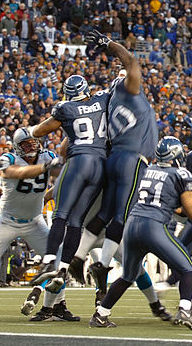
Members of the Seahawks special teams blocking a point-after-touchdown.
The Seahawks are the only NFL team to switch conferences twice in the post-merger era. The franchise began play in 1976 in the NFC West division but switched conferences with the Buccaneers after one season and joined the AFC West. This realignment was dictated by the league as part of the 1976 expansion plan, so that both expansion teams could play each other twice and every other NFL franchise once during their first two seasons. In 1983, the Seahawks hired Chuck Knox as head coach, who would win the NFL Coach of the Year Award in 1984. Finishing with a 9-7 record, the Seahawks made their first post-season appearance, defeating the Denver Broncos in the Wild Card Round, the Miami Dolphins in the Divisional round, before finally making it to the AFC Championship, where they were a win short of making their first Super Bowl appearance, losing to the eventual champion Los Angeles Raiders. The following season, the Seattle Seahawks had their then best record in franchise history, finishing 12-4. They would not return to the playoffs again until drafting linebacker Brian Bosworth in 1987. The Seahawks would win their first division title in 1988. From 1989 to 1998, the Seattle Seahawks would miss the post season for many seasons resulting in a near relocation, drafting of poor quality players, and short term bankruptcy. In 1997, Microsoft co-creator Paul Allen purchased the team, and in 1999 Mike Holmgren was hired as head coach. He would coach for 10 seasons. The Seahawks won their second division title, as well as a wild card berth in the playoffs. In 2002, the Seahawks returned to the NFC West as part of an NFL realignment plan that gave each conference four balanced divisions of four teams each. This was done after the Houston Texanswere added as the thirty-second team. This realignment restored the AFC West to its initial post-merger roster of original AFL teams Denver, San Diego, Kansas City, and Oakland.
They won the NFC Championship Game in 2005, and went on to lose in Super Bowl XL against the Pittsburgh Steelers (though it was not without controversy as NFL Films has Super Bowl XL at number 8 on its top ten list of controversial calls[5]). Before 2005, Seattle had the longest drought of playoff victories of any NFL team, dating back to the 1984 season. That drought was ended with a 20–10 win over the Washington Redskins in the 2005 playoffs. The all-time Seahawks playoff record is 8-11.
As a tribute to the raucous fans that made the Kingdome the loudest stadium in the NFL the Seahawks retired the number 12 on December 15, 1984. Since then #12 Jerseys have been sold by the team and worn by Seahawk fans, often with the name "Fan" on the back. The Seahawks also have a ceremony before each home game where a flag bearing the #12 is raised by a prominent individual. In the 2005 season the fans were again making a difference in games and were recognized with the presentation of a special game ball for their efforts in a game against the New York Giants, a game in which the Giants committed 11 false start penalties in large part because of the crowd noise.[6]
The team's use of the phrase "12th Man" was in a legal limbo for a while between the 2005 and 2006 seasons when Texas A&M University sued the team for trademark infringement. Before going to trial, both parties settled out of court with Seattle agreeing to acknowledge ownership rights to the 12th Man slogan to A&M. In return the Seahawks were allowed to continue to use the phrase.[7]
Starting in the 1998 season, Blitz has been the Seahawks' official mascot. In the 2003 and 2004 seasons, a hawk named Faith would fly around the stadium just before the team came out of the tunnel. However, because of her relative small size and an inability to be trained to lead the team out of a tunnel, Faith was replaced by an augur hawk named Taima before the start of the 2005 season. Taima started leading the team out of the tunnel in September 2006.[8] Beginning in 2004, the Seahawks introduced their drum line, the Blue Thunder. The group plays at every home game as well as over 100 events in the Seattle community.[9]
In the 2010 NFL season, the Seahawks made history by making it into the playoffs despite having a 7-9 record. The reason that they managed to do so was because they had the best record in the worst division at the time (Seahawks 7-9, Rams 7-9, 49ers 6-10, Cardinals 5-11) and won the decisive season finale against the Rams. In the playoffs, the Seahawks won in their first game against the then-defending Super Bowl champs, the New Orleans Saints, 41-36. The Seahawks made even more history during the game with Marshawn Lynch's 67-yard run, breaking 7 or so tackles, to clinch the victory. It even made the crowd cheer so loudly that they registered on a nearby seismometer from the vibrations of the sound.[10] The Seahawks lost to the Bears in their second game, 35-24.
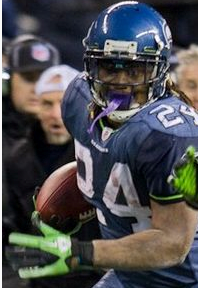
The 2012 NFL Season started with doubt, as the Seahawks lost their season opener against the Arizona Cardinals, after the highly touted Seattle defense gave up a go-ahead score late in the fourth quarter,and rookie quarterback Russell Wilson failed to throw the game winning touchdown after multiple attempts in the red-zone. However, Russell Wilson and the Seahawks went 4-1 in their next five games en route to an 11-5 overall record (their first winning record since 2007). Their 2012 campaign included big wins over the Green Bay Packers, New England Patriots, and San Francisco 49ers. The Seahawks went into the playoffs as the #5 seed and the only team that season to go undefeated at home. In the Wild Card Round, the Seahawks over came a 14 point deficit to defeat the Washington Redskins. This was the first time since the 1983 Divisional Round that the Seahawks won a playoff game on the road. Unfortunately, in the 2013 Divisional Round, overcoming a 20 point, fourth quarter deficit wouldn't be enough to defeat the #1 seed Atlanta Falcons. An ill-advised timeout and a defensive breakdown late in the game cost the Seahawks their season, as they lost, 30-28. QB Russell Wilson won the 2012 Pepsi Max Rookie of the Year award.
Headquarters and training camps
During the Seahawks' first ten seasons (1976–85), the team's headquarters was at Carillon Point on the shores of Lake Washington. The summer training camps were initially held at Eastern Washington University in Cheney, just southwest of Spokane. When the team's new headquarters across town in Kirkland were completed in 1986, the Seahawks held training camp at home for the next eleven seasons (1986–96), staying in the dormitories of the adjacent Northwest College. In Dennis Erickson's third season as head coach, the team returned to the hotter and more isolated Cheney in 1997, where they held training camp through 2006. In 2007, training camp returned to their Kirkland facility, because of the scheduled China Bowl game that was later canceled. In 2008, the Seahawks held the first three weeks of camp in Kirkland, then moved to the new 19-acre (77,000 m2) Virginia Mason Athletic Center (VMAC) on August 18 for the final week of training camp. The new facility, adjacent to Lake Washington in Renton, has four full-size practice fields: three natural grass outdoors and one FieldTurf indoors.[11][12]
Logos and uniforms
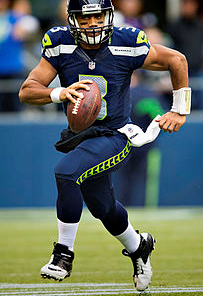
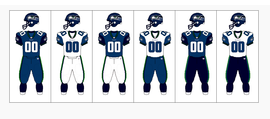
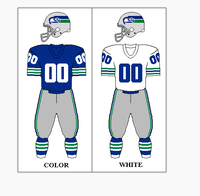
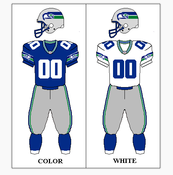
When the Seahawks debuted in 1976, the team's logo was a stylized royal blue and forest green osprey's head based on Northwestern tribal art.[13] The helmet and pants were silver while the home uniforms were royal blue with white, blue and green arm stripes. The road uniform was white with blue and green arm stripes. Black shoes were worn for the first four seasons, one of the few NFL teams that did in the late 1970s. They then changed to white shoes in 1980.[14]
In 1983, coinciding with the arrival of Chuck Knox as head coach, the uniforms were updated slightly. The striping on the arms now incorporated the Seahawks logo, and the TV numbers moved onto the shoulders. Helmet facemasks changed from gray to blue. Also, the socks went solid blue at the top, and white on bottom. [15] In the 1985 season, the team wore 10th Anniversary patches on the right side of their pants. It had the Seahawks logo streaking through the number 10. Starting in the 1989 NFL season, jerseys were no longer sand-knit. In 1994, the year of the NFL's 75th Anniversary, the Seahawks changed the style of their numbering to something more suitable for the team; Pro Block from then until 2001. That same year, the Seahawks wore a vintage jersey for select games resembling the 1976-82 uniforms. However the helmet facemasks remained blue. The logos also became sewn on instead of being screen-printed. In 2000, Shaun Alexander's rookie year and Cortez Kennedy's last, the Seattle Seahawks celebrated their 25th Anniversary; the logo was worn on the upper left chest of the jersey. In 2001, the Seahawks switched to the new Reebok uniform system still in their current uniforms, but it would be their last in this uniform after the season ended. Previously, the team's uniforms were made by Wilson, Wilson/Staff, Russell Athletics, Logo Athletics, and Puma.
In March 1, 2002, to coincide with the team moving to the NFC as well as the opening of Seahawks Stadium (which would later be renamed Qwest Field, then CenturyLink Field), both the logo and the uniforms were heavily redesigned. The Wordmark was designed by Mark Verlander and the logo was designed by NFL Properties in-house design team. The colors were modified to a lighter "Seahawks Blue", a darker "Seahawks Navy" and lime green piping. The helmets also were changed from silver to the lighter "Seahawks Blue" color after a fan poll was conducted. Silver would not be seen again until 2012. The logo artwork was also subtly altered, with an arched eyebrow and a forward-facing pupil suggesting a more aggressive-looking bird. At first, the team had planned to wear silver helmets at home and blue helmets on the road, but since NFL rules forbid the use of multiple helmets, the team held the fan poll to decide which color helmet would be worn. The team has usually worn all blue at home and all white on the road since 2003, but late in the 2009 season, the Seahawks wore the white jersey-blue pants combo. The blue jersey and white pants combo has been worn for only one regular season game, the 2005 season opener at the Jacksonville Jaguars, while the white jersey and blue pants combination has not been worn regularly since late in the 2002 season, with the exception of late in the 2009 season. In 2009, the Seahawks once again wore the white jersey and blue pants combination for road games against the Minnesota (November 22), St. Louis (November 29), Houston (December 13) and Green Bay (December 27).
The Seahawks wore their home blue jerseys during Super Bowl XL despite being designated as the visitor, since the Pittsburgh Steelers, the designated home team, elected to wear their white jerseys.
With the Oakland Raiders wearing their white jerseys at home for the first time ever in a game against the San Diego Chargers on September 28, 2008, the Seahawks have become the only NFL team to have never worn their white jerseys at home.
On September 27, 2009, the Seahawks wore lime green jerseys for the first time, paired with new dark navy blue pants in a game against the Chicago Bears. The jerseys matched their new sister team, the expansion Seattle Sounders FC of Major League Soccer who wear green jerseys with blue pants. On December 6, 2009, the Seahawks wore their Seahawks blue jersey with the new dark navy blue pants for the first time, in a game against the San Francisco 49ers. The Seahawks broke out the same combo two weeks later against the Tampa Bay Buccaneers, and two weeks after that in the 2009 regular season finale against the Tennessee Titans. In December 2009, then-coach Jim Mora announced that the new lime green jerseys were being retired because the team did not win in them, because he liked the home jerseys better, and added that the home jersey is a better match for the navy pants.[16]In the same press conference, he stated that the new navy pants "felt better" on players as opposed to the Seahawks blue pants. For the 2010 season, Seattle returned to the traditional all "Seahawks Blue" at home and all white on the road.
On April 3, 2012, Nike, which took over as the official uniform supplier for the league from Reebok, unveiled new uniform and logo designs for the Seahawks for the 2012 season. The new designs incorporate a new accent color, "Wolf Grey", and the main colors are "College Navy" and "Action Green". The uniforms incorporate "feather trims", multiple feathers on the crown of the helmet, twelve feathers printed on the neckline and down each pant leg to represent the "12th Man", referring to the team's fans.[17] The Seahawks have three different jersey colors: navy blue, white, and an alternate gray jersey. The Seahawks will have three different pants: navy blue with green stripes, gray with navy blue stripes, and white with navy blue stripes. Their new logo replaces the Seahawk blue with gray.
The Seahawks wore their Nike home blue jerseys for the first regular season game on September 16, 2012 against the Dallas Cowboys. The uniform Marshawn Lynch wore in that game is preserved at the Pro Football Hall of Fame. [18] On September 9, 2012, the Seahawks wore their Nike white away jerseys for the first regular season game against the Arizona Cardinals, and on December 16, 2012 they wore their Alternate Wolf Grey jerseys for the first time against the Buffalo Bills.
Seasons
Main article: List of Seattle Seahawks seasons
As of the 2012 season, the Seattle Seahawks have competed in 37 NFL seasons, dating back to their expansion year of 1976. The team has compiled a 280–300 record (289–312 counting the playoffs) for a .483 winning percentage (.481 counting the playoffs). Seattle has reached the playoffs in eleven separate seasons, including in the 2005 season when they lost Super Bowl XL to the Pittsburgh Steelers. In the 2010 season, the Seahawks became the first team in NFL history to earn a spot in the playoffs with a losing record (7–9, .438); that year, 7 teams in the NFL with a record of 7–9 or better did not make the playoffs, including two 10–6 teams. However, the Seahawks would go on to defeat the reigning Super Bowl champion New Orleans Saints in the Wild Card round, becoming the first team ever to win a playoff game with a losing record. They are also the oldest existing team in the NFL to never have had a tie game, not even in the preseason.
35th Anniversary Team (2010)
The 35th Anniversary team was voted upon by users on Seahawks.com and announced in 2010.[19]
| Player | Position | Number | Years |
| Matt Hasselbeck | QB | 8 | 2001–2010 |
| Shaun Alexander | RB | 37 | 2000–2007 |
| Mack Strong | FB | 38 | 1993–2007 |
| John Carlson | TE | 89 | 2008–2012 |
| Steve Largent | WR | 80 | 1976–1989 |
| Brian Blades | WR | 89 | 1988–1998 |
| Bobby Engram | WR | 84 | 2001–2008 |
| Walter Jones | LT | 71 | 1997–2010 |
| Steve Hutchinson | LG | 76 | 2001–2005 |
| Robbie Tobeck | C | 61 | 2000–2006 |
| Bryan Millard | RG | 71 | 1984–1991 |
| Howard Ballard | RT | 75 | 1994–1998 |
| Jacob Green | DE | 79 | 1980–1992 |
| Michael Sinclair | DE | 70 | 1991–2001 |
| Cortez Kennedy | DT | 96 | 1990–2000 |
| Joe Nash | DT | 72 | 1982–1996 |
| Chad Brown | OLB | 94 | 1997–2004 |
| Rufus Porter | OLB | 97 | 1988–1994 |
| Fredd Young | ILB | 50 | 1984–1987 |
| Lofa Tatupu | MLB | 51 | 2005–2010 |
| Marcus Trufant | CB | 23 | 2003–2012 |
| Dave Brown | CB | 22 | 1976–1986 |
| Shawn Springs | NB | 24 | 1997–2003 |
| Kenny Easley | SS | 45 | 1981–1987 |
| Eugene Robinson | FS | 41 | 1985–1995 |
| Norm Johnson | K | 9 | 1982–1990 |
| Rick Tuten | P | 14 | 1991–1997 |
| Steve Broussard | KOR | 31 | 1995–1998 |
| Nate Burleson | PR | 81 | 2006–2009 |
Retired numbers
| Seattle Seahawks retired numbers | ||||
|---|---|---|---|---|
| N° | Player | Position | Tenure | N° Retirem. |
| 12 | Fans (12th Man) | - | 1976–present | 1984 [20] |
| 71 | Walter Jones | OT | 1997-2009 | 2010 |
| 80 1 | Steve Largent | WR | 1976-1989 | 1996 |
| 96 | Cortez Kennedy | DT | 1990-2000 | 2012 [21] |
• 1 Jerry Rice wore #80 for his 2004 stint with the Seahawks. According to Rice, it was the team that offered him to wear the #80, with Largent's permission.[22]
• Several other players and individuals related to the team have been honored by their induction into the Seattle Seahawks Ring of Honor
Pro Football Hall of Famers
| Seattle Seahawks Hall of famers | ||||
|---|---|---|---|---|
| N° | Player | Position | Tenure | Inducted |
| 34 | Franco Harris | FB | 1984 | 1990 |
| 80 | Steve Largent | WR | 1976–89 | 1995 |
| 81 | Carl Eller | DE | 1979 | 2004 |
| 1 | Warren Moon | QB | 1997–98 | 2006 |
| 93 | John Randle | DT | 2001–03 | 2010 |
| 80 | Jerry Rice | WR | 2004 | 2010 |
| 96 | Cortez Kennedy | DT | 1990-2000 | 2012 |
Note: Although Mike McCormack served as head coach, president, and general manager for the Seahawks, he is only listed in the Pro Football Hall of Fame for his contributions as a tackle for the New York Yanks and the Cleveland Browns.
Sea Gals (Cheerleaders)
The Seahawks cheerleaders are called the Sea Gals.[23] During the off-season, a select performing group from the Sea Gals travel parades and with other NFL Cheerleaders on the road.
12th Man
The 12th Man refers to the fan support of the Seahawks. In the early years of the franchise, the number 12 jersey with "Fan" across back, was popular with supporters of the expansion franchise. The home stadium, the Kingdome, was a particularly loud and disruptive environment, with fans priding themselves for their ability to disrupt opposing offenses by yelling in key moments. The practice was so successful, the NFL temporarily adopted a series of rules changes in the late 1980s which penalized the home team if their fans were disruptive of the visitor's playcalls.
The Seahawks retired the number #12 jersey on December 15, 1984 as a tribute to their fans.
In 2002, the Seahawks began playing at CenturyLink Field. Every regular season and playoff game at CenturyLink Field since the 2nd week of the 2003 season has been played before a sellout crowd.[24] Inside CenturyLink Field, the noise level can reach as high as 112 dB.[25] This has caused problems for opposing teams, causing them to commit numerous false starts and penalties. From 2005 through the beginning of the 2010 season, opponents at CenturyLink Field committed a league-high 107 false start penalties.
Prior to kickoff of each home game, the Seahawks salute their fans in the NFL by raising the 12th man flag at the south end of the stadium. Current and former players, coaches, local celebrities, prominent fans, Seattle-area athletes, and current owner Paul Allen have raised the flag.
In September 1990, Texas A&M filed a trademark application for the "12th Man" term. In January 2006, Texas A&M filed suit against the Seattle Seahawks to protect the trademark and in May 2006, the dispute was settled out of court. In the agreement, Texas A&M licensed the Seahawks to continue using the phrase.
Team owners
• The Nordstrom family: 1976–1988
• Ken Behring & Ken Hofmann: 1988–1996
• Paul Allen: 1997–present
As of 2009, the Seahawks' flagship station is KIRO (AM) 710 kHz - KIRO-FM 97.3 MHz. Games are heard on 47 stations in five states and Canada making the Seahawks the NFL's largest area in terms of network coverage. The current announcers are former Seahawks players Steve Raible (who was the team's color commentator from 1982 to 2003 and Warren Moon. The Raible-Moon regular season pairing has been together since 2004 (during the preseason Moon works for the local television broadcast so the color commentary is split between former Seahawks Paul Moyer, Sam Adkins, and Brock Huard). Pete Gross, who called the games from 1976 until just days before his death from cancer in 1992, is a member of the team's Ring of Honor. Other past announcers include: Steve Thomas 1992 to 1997, Lee Hamilton also known as "Hacksaw" 1998 to 1999, and Brian Davis 2000 to 2003.
Preseason games not shown on national networks were produced by Seahawks Broadcasting and televised by KING-TV, channel 5 (and, in 2008, also on sister station KONG-TV since KING, an NBC affiliate, was committed to the Summer Olympics in China). Seahawks Broadcasting is the Emmy Award Winning in-house production and syndication unit for the Seattle Seahawks. Curt Menefee (the host of Fox NFL Sunday) has been the Seahawks TV voice since the 2009 preseason. Starting in the 2012 season, KCPQ-TV, which airs most of the Seahawks regular season games (as the Seattle-Tacoma area's Fox affiliate), will be the new television partner for the team, while simulcasts of any Seahawks games on Monday Night Football or NFL Network will air on KONG-TV. In addition, any Saturday or Sunday afternoon games broadcast by CBS (with the Seahawks hosting an AFC opponent) will air on local CBS affiliate KIRO-TV.
Share this page




















